Saga Dawa Duchen and the Month of Merits: Buddha’s Birth, Enlightenment and Paranirvana Celebrated With “Merit Multiplied”
The entire fourth month of the lunar year is meritorious, this year running between May 9 and June 6. On the full moon day (15th day) of this sacred month — this year on Thursday the 23rd– we...

 Saga Dawa, the most sacred day of the year, celebrated in a march at Gantok in Sikkhim.
Saga Dawa, the most sacred day of the year, celebrated in a march at Gantok in Sikkhim.
The entire fourth month of the lunar year is meritorious, this year running between May 9 and June 6. On the full moon day (15th day) of this sacred month — this year on Thursday the 23rd– we celebrate Saga Dawa Duchen:
Birth of Shakyamuni Buddha, the Conqueror Enlightenment of Gautama Shakyamuni Buddha Buddha’s Paranirvana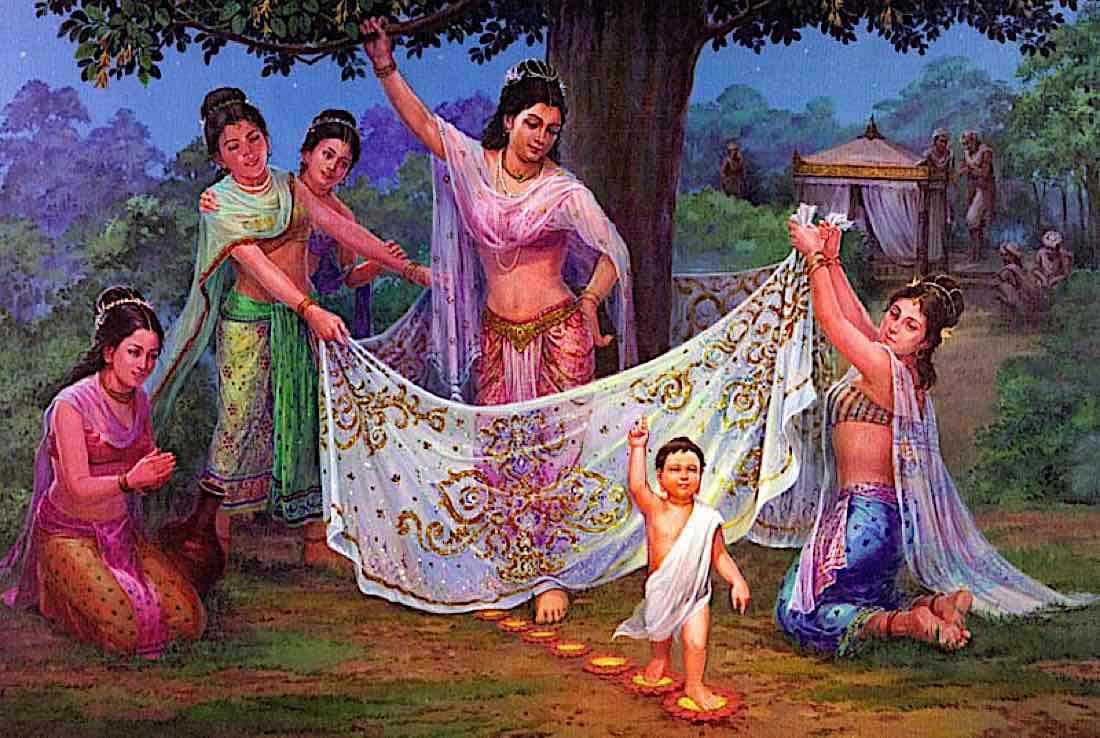 Buddha’s wonderful birth.
Buddha’s wonderful birth.
Although these events were separated by years, the history of his great life reveals that the three most important events occurred on the full moon of the 4th month. For this reason, according to Lama Zopa:
“Saka Dawa Duchen is one of the four great holy days of the Tibetan calendar, each of which celebrates an anniversary of Shakyamuni Buddha’s display of extraordinary powerful deeds for sentient beings’ sake. On these four days, karmic results are multiplied by 100 million, as taught in the Vinaya text Treasure of Quotations.”
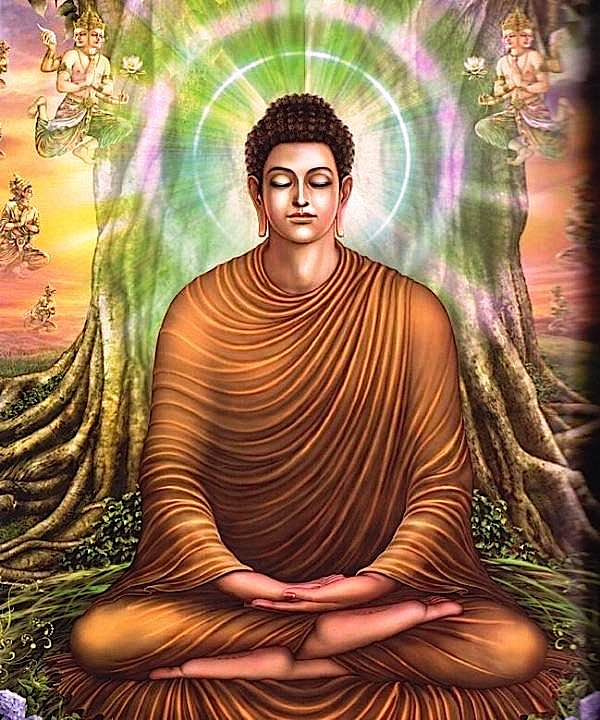 Buddha under the Bodhi Tree, where he meditated on suffering. He ultimately found Enlightenment, and a way to relieve our suffering.The Sacred Month also has multiplied merit and this year 2024, runs from May 9 – to June 6 (Month 4 of Lunar Calendar)
Saga Dawa Duchen, the Birth, Enlightenment and Paranirvana Day celebrated on the full moon of the 4th month: May 23, 2024
Buddha under the Bodhi Tree, where he meditated on suffering. He ultimately found Enlightenment, and a way to relieve our suffering.The Sacred Month also has multiplied merit and this year 2024, runs from May 9 – to June 6 (Month 4 of Lunar Calendar)
Saga Dawa Duchen, the Birth, Enlightenment and Paranirvana Day celebrated on the full moon of the 4th month: May 23, 2024
Did you know?
Many Buddhists engage in acts of generosity, such as giving to the poor and freeing animals Reciting mantras and reading Buddhist scriptures are common practices on this day Lighting butter lamps and making circumambulations around stupas are traditional observances Tibetans often refrain from eating meat during the entire month of Saga Dawa The month of Saga Dawa is considered a time for increased spiritual practice and reflection Saga Dawa Duchen is a public holiday in Tibet and other regions with significant Tibetan Buddhist populations The festival promotes the values of compassion, kindness, and mindfulness Butter lamps. Photo By Yasunori Koide
Butter lamps. Photo By Yasunori Koide
Merit of Paramitas
Increased merit activities include any of the Paramitas:
Generosity of Dana, supporting Dharma activities, helping “Spread the Dharma”– for instance, buying, coping, and circulating sutras, supporting Dharma centers, becoming a patron of a teaching event and so on. Another powerful form of generosity during Saga Dawa Duchen is Life Release, the practice of saving lives of animals destined to be killed. This act is believed to extend one’s own lifespan and foster positive karma. Imagine setting free a bird or fish, granting them a new lease on life—it’s profoundly symbolic and spiritually uplifting. Participating in fasting retreats is also highly regarded. During these retreats, you abstain from meals for a specified period, focusing instead on prayers and meditation. This not only purifies your body but also sharpens your spiritual focus. Lighting butter lamps is another common practice. Each lamp lit is a symbol of enlightenment and wisdom, guiding souls towards the light of Dharma. It’s a simple yet deeply meaningful act. Reciting spiritual texts, especially those that involve praises to deities like Tara or rituals such as the Mamo Pacification Ritual, also yield immense merit. Reading these texts aloud not only transforms your own mind but also benefits all sentient beings through the power of spoken words. Supporting Dharma centers by attending their events or even making regular donations can further your spiritual journey while ensuring the longevity of these crucial institutions. Your contribution helps keep the teachings accessible to everyone and maintains a sacred space for practice. Sponsorship of religious activities, such as funding rituals or ceremonies aimed at invoking blessings and protection for all beings, is another meritorious act. These activities often require funds to purchase offerings and make arrangements, and your sponsorship can make these events possible.Engaging in these practices during Saga Dawa Duchen not only elevates your own spiritual state but contributes to the collective merit and well-being of all sentient beings. Remember, every act of generosity, no matter how small, multiplies a hundred million times during this auspicious period. So, seize the opportunity to do good and spread the light of Dharma far and wide.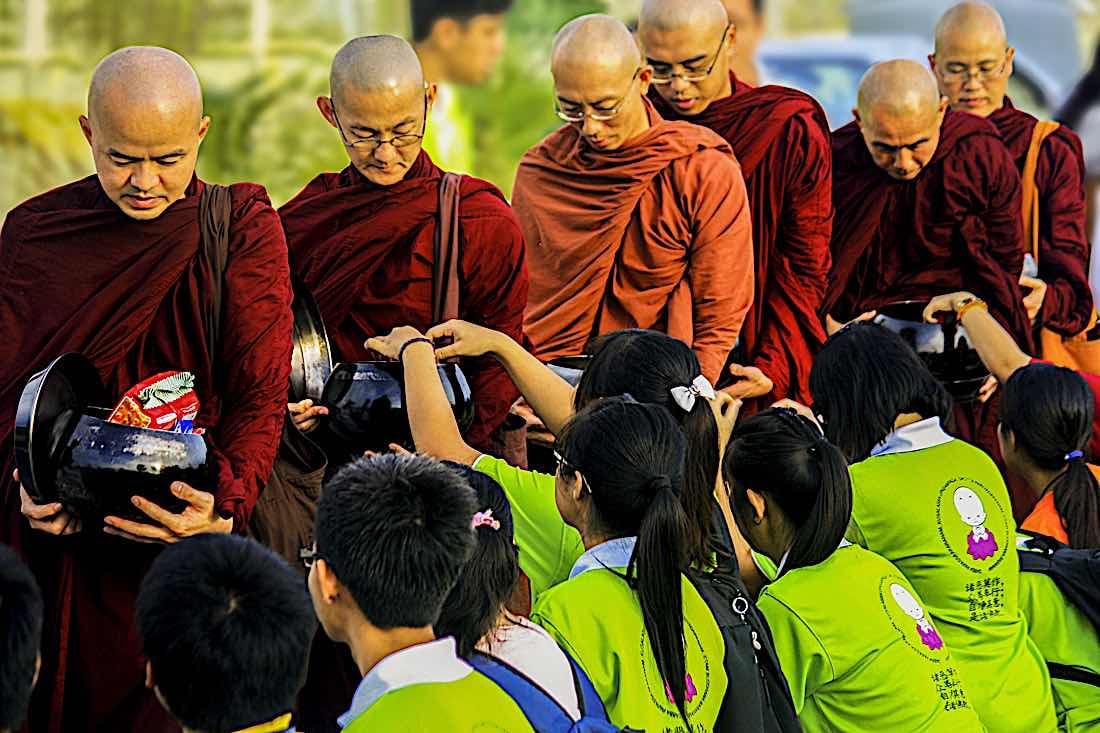 Youth give “dana” to monastic Sangha, a meritorious action.
Youth give “dana” to monastic Sangha, a meritorious action.
Saga Dawa Duchen
The most important day in the month (perhaps for the entire year, for many Buddhists) is Saga Dawa Duchen on the full moon. Duchen means “great occasion,” and this year falls on the full moon day, May 23rd. It is similar to Vesak in Theravadin Buddhism — celebrating the birth, Enlightenment and Paranirvana of Shakyamuni Buddha, but is based on the Tibetan lunar calendar. Both are the “4th month” of the lunar calendars, but they are calculated differently. (See this feature on lunar confusion for clarification>>)
The day of the “Great Occasion” this year on May 23, 2024 is the best day of the entire year for “making merit” for the benefit of all sentient beings. In addition to the 8 precepts, other activities recommended include:
Strongly recommended by Lama Zopa: do a Shakyamuni Buddha Puja. There are long and short forms of this Puja, downloadable here from FPMT>> Reciting the Sutra Remembering the Three Jewels [For a feature on the benefits of reciting sutra out loud, see this special story>>] Your regular daily practices. Reciting sutras, such as Vajra Cutter Sutra, Sutra of Golden Light, and Sanghata Sutra Reciting other prayers, such as Chanting the Names of Manjushri, and King of Prayers Undertaking Nyung nes Performing self-initiation, for those who fulfilled the necessary prerequisites (normally only for people who have completed a particular retreat protocol and fire puja.) Performing Lama Chopa, and at either the beginning of the practice or during the lamrim section, you can meditate on emptiness Reciting the names of the Thirty-Five Buddhas, with prostrations Reciting Vajrasattva mantras Reciting OṂ MAṆI PADME HŪṂ with bodhichitta Meditating on emptiness and dependent arising Meditating on bodhichitta Practicing tonglen Rejoicing Liberating animals Listening to Dharma teachings (live or online is fine).Taking the 8 Precepts for a day
The late, great Lama Zopa recommends taking the full 8 precepts — the precepts of a monk or nun (not necessarily shaving the head) — for the day. Traditionally, lay disciples follow five of the precepts — but for the day they take all eight. This should be done in the early morning (earlier the better!) He explains:
“Taking the eight Mahayana precepts is a way to make life meaningful, to take its essence all day and night, by taking vows,” Lama Zopa Rinpoche has taught. “It is so simple. It is just for one day. Just for one day. It makes it so easy.”
Here is a video of Garchen Rinpoche offering Refuge Vow:
You can certainly take the precepts simply by action and conscious decision. You don’t have to take formal precepts. Just set your mind and, for the day, ensure you do your best:
1. I undertake to abstain from causing harm and taking life of any kind
2. I undertake to abstain from taking what is not given.
3. I undertake to abstain from sexual misconduct.
4. I undertake to abstain from wrong speech: telling lies, deceiving others, manipulating others, using hurtful words.
5. I undertake to abstain from using intoxicating drinks and drugs, which lead to carelessness.
The additional precepts on Wesak and other special ceremonial days (or for non-lay practitioners all the time) are:
6. I undertake to abstain from eating at the wrong time—the correct time is after sunrise but before noon.
7. I undertake to abstain from singing, dancing, playing music, attending entertainment performances, wearing perfume, and using cosmetics and garlands or decorations.
8. I undertake to abstain from luxurious places for sitting or sleeping, and overindulging in sleep.
Please be aware that by taking the lineage of the eight Mahayana precepts from Lama Zopa Rinpoche, Rinpoche will become one of your gurus.” You can download the PDF text for recitation along with Lama Zopa here>>
Prajna (Wisdom): Understanding the true nature of reality, leading to enlightenment. Sila (Morality/Discipline): Ethical behavior and adherence to moral precepts. Virya (Energy/Perseverance): Diligence and effort in pursuing spiritual goals. Kshanti (Patience): Cultivating tolerance and forbearance, even in difficult situations. Upaya (Skillful Means): Applying wisdom and compassion effectively to help others. Samadhi (Meditative Concentration): Developing deep states of focused meditation and mental clarity. Karuna (Compassion): Developing a deep sense of empathy and care for the suffering of all beings. Mudita (Sympathetic Joy): Rejoicing in the happiness and success of others. Upeksa (Equanimity): Maintaining mental calm and balance, regardless of external circumstances. Danaparamita (Generosity): The practice of giving selflessly to support others. Dana (Generosity): You can make donations to a local Buddhist temple, or sponsor the lighting of butter lamps as a part of your offerings. Sila (Good Conduct): Be conscious about leading a life of morality, by being truthful and not inflicting harm on others. This could involve activities like helping others in need. Kshanti (Patience): Practice patience through understanding and forgiving others, regardless of the difficulties. Virya (Diligence): Break out of comfort zones and commit to reading or reciting spiritual texts or sutras during Saga Dawa to obtain merit. Dhyana (Meditative Concentration): Engage in longer meditation sessions or join a fasting retreat, helping you to develop a deeper sense of peace and tranquility. Prajna (Wisdom): Take time to study the teachings by revered Buddhist figures or Lama Zopa Rinpoche’s recommended practices for Saka Dawa Duchen. Upaya (Means or Expedient Measures): Offer your help towards organising religious events, circulating sutras, or helping in any other tasks required during Saga Dawa celebrations. Pranidhana (Resolution or Vow): Make a conscious resolution to refrain from negative actions and increase positive behaviors during Saga Dawa, since each action’s merit is multiplied. Bala (Power or Spiritual Potency): Engage in practices such as Mamo Pacification Ritual, and other rituals to praise the Glorious Goddess, harnessing the spiritual power of these rituals. Jnana (Knowledge): Strive to enhance your knowledge about Buddhism by studying scriptures, listening to teachings and engaging in thoughtful discussions with fellow practitioners during Saga Dawa.Buddha’s Life — Based on Latest Archeological Evidence
For a full story on the archaeological evidence, and his timeline, see>>563 B.C. Conception to the Sakyas
Sakyamuni (Shakyamuni) Gautama Buddha’s conception — in much of Asia, conception is the celebratory date, rather than the actual date of birth. [2] Famously, Queen Maha Maya, Buddha’s mother, had a conception dream of a white elephant with six tusks descending from heaven to enter her womb. His title Sakyamuni (pronounced Shakyamuni) literally means ‘sage’ of the Sakyans — where Sakya was his father’s kingdom or oligarchic republic (located in modern-day Nepal). Muni literally means “sage.” Śākyamuni (शाक्यमुनि) is title of Buddha fist cited in Mahāprajñāpāramitāśāstra (chapter VI).
 According to legend, Baby Buddha took seven steps to each of the directions immediately after his miraculous birth.
According to legend, Baby Buddha took seven steps to each of the directions immediately after his miraculous birth.
563 B.C. Siddartha’s Birth in Lumbini Nepal
Buddha was actually born Prince Siddartha, in Lumbini Nepal. According to tradition:
“Buddha emerged from his mother’s side, as she stood leaning against a tree, in a painless and pure birth.” [2]
He was named Siddartha (or Sarvathasiddha) — literally meaning “a man who achieves his goals” — by his father the king, who was determined he would be a great worldly king and conqueror, not a Buddha as predicted by the sages. His mother passed away, and he was brought up by his aunt Mahaprajapati.
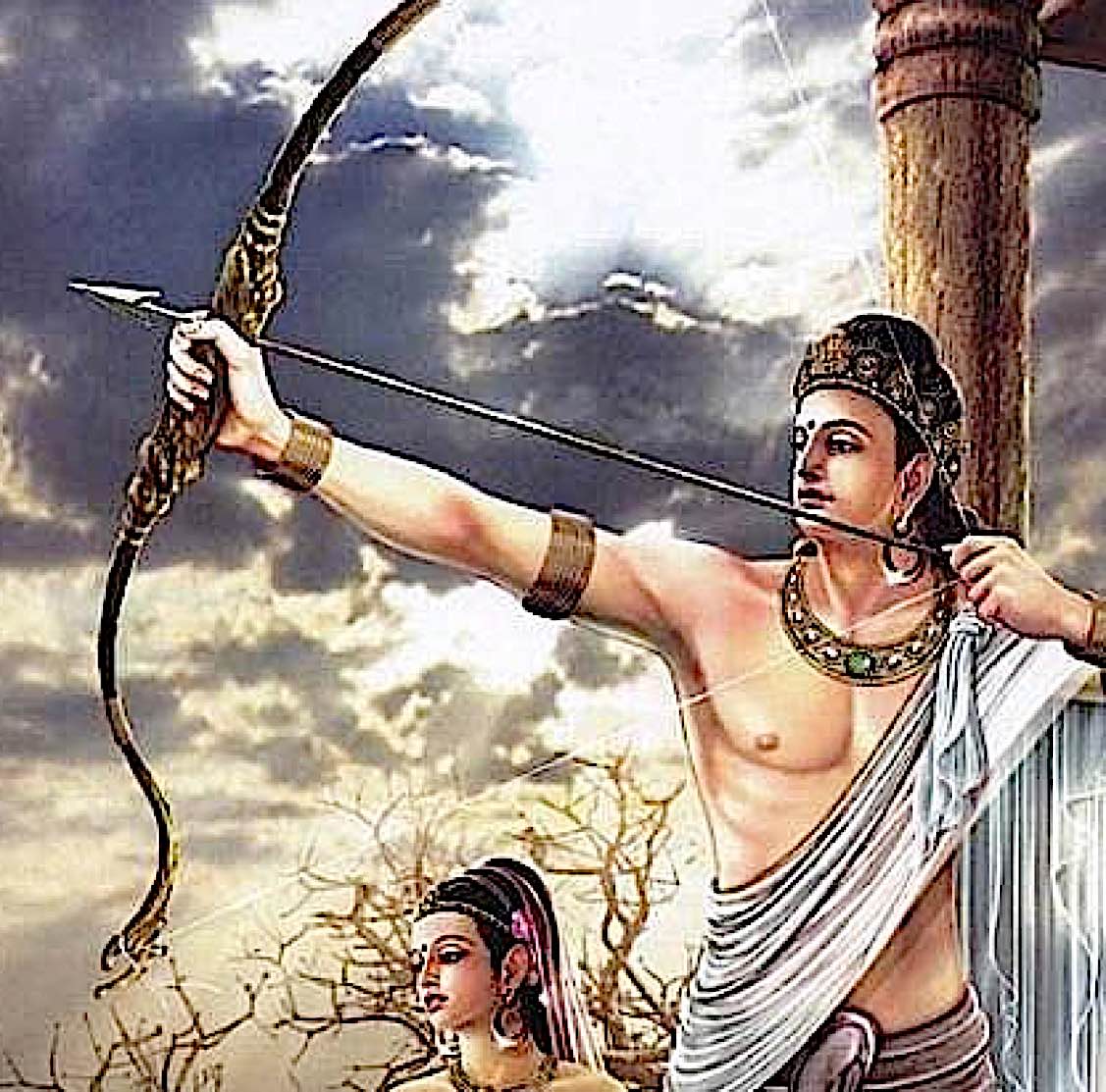 Siddartha Buddha grew up in the palace and was an expert in martial arts.
Siddartha Buddha grew up in the palace and was an expert in martial arts.
548 B.C. Siddartha’s marriage to Yasodhara
His father the king determined he must be sheltered from the suffering of the world to remove any causes that might arise compassion in the young prince. True to his father’s aspirations, he was brought up a privileged prince, sequestered in the palace. He was married to young Yasodhara, who conceived their son Rahula.
Siddartha grew up in Kapilavastu, the capital, and became very accomplished in “kingly arts” including the martial arts.
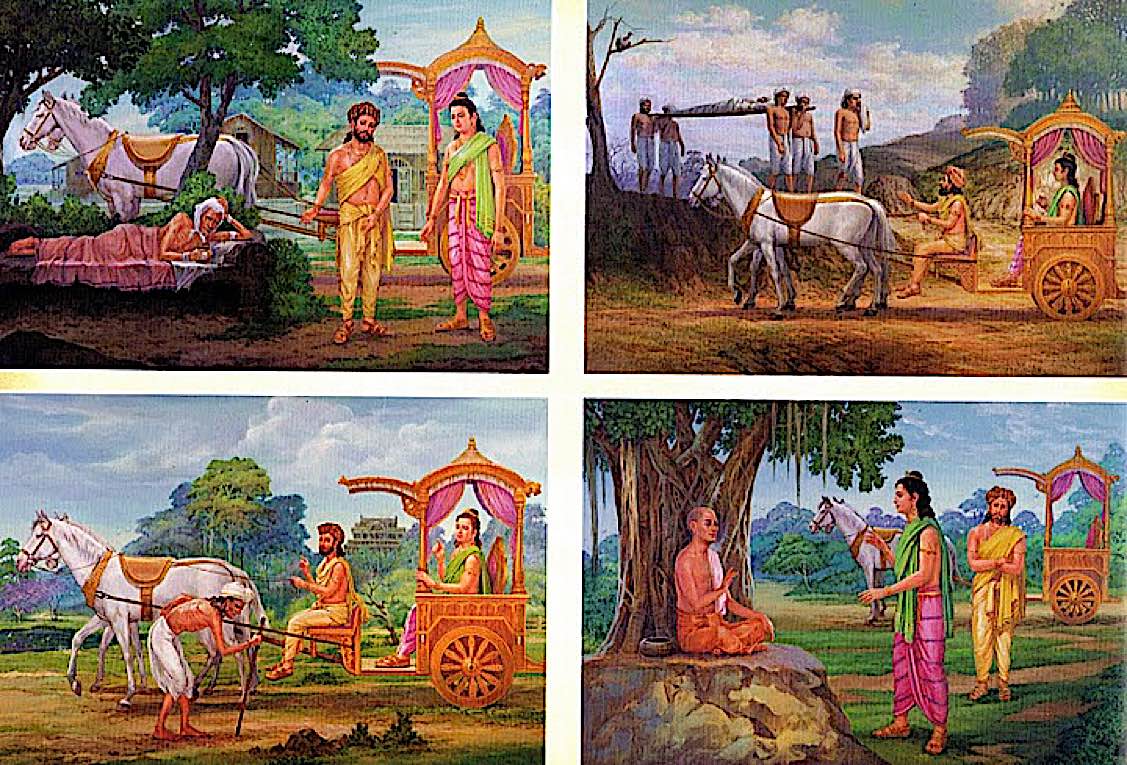 Siddartha leaves the palace and sees the four sights: poverty, illness, old age and death.
Siddartha leaves the palace and sees the four sights: poverty, illness, old age and death.
534 B.C. Buddha sees the four sights: Suffering
True to predictions of the sages — and despite his father’s fiercely protective tactics — Prince Siddartha escaped the palace and saw the four sights of suffering: poverty, illness, old age, and death. He also saw religious ascetics. His “existential crisis” [2] led to his life’s mission — to release the world from all suffering.
 Buddha determines to leave his wife Yasodhara and son Rahula to seek Enlightenment — to release them from ultimate suffering in Samsara. Later, they both become his followers.
Buddha determines to leave his wife Yasodhara and son Rahula to seek Enlightenment — to release them from ultimate suffering in Samsara. Later, they both become his followers.
534 B.C. Siddartha leaves home
With compassion awake in the young Prince Siddartha, he became driven to overcome the suffering of Samsara. In a dramatic moment, Siddartha determined to leave home — quietly leaving the palace to avoid his father’s guards. He knew he must abandon his conventional, privileged life, to seek the answers that would save all beings from the eternal cycle of suffering.
Dramatically, he left his beloved wife and child — knowing he must for the ultimate benefit — cut his hair and left behind even his inseparable horse. Cutting his hair was a symbol of leaving behind his ordinary life. He traveled south, seeking out other spiritual seekers, and ended in Magadha (current Bihar) where he begged on the streets.
 Buddha Tarot by Robert Place features the life and journey to Enlightenment of Siddartha Buddha as the major Aracana, in place of the “fool’s journey” to spiritual enlightenment. On the top (left to right) are the white elephant that descended to Queen Maha in the conception dream, Siddartha leaving the palace on his horse, Siddartha cutting his hair to become an ascetic, then Buddha’s first sermon.
Buddha Tarot by Robert Place features the life and journey to Enlightenment of Siddartha Buddha as the major Aracana, in place of the “fool’s journey” to spiritual enlightenment. On the top (left to right) are the white elephant that descended to Queen Maha in the conception dream, Siddartha leaving the palace on his horse, Siddartha cutting his hair to become an ascetic, then Buddha’s first sermon.533 B.C. Siddartha Meditates in Magadha
Like most spiritual seekers, Siddartha sought out and trained with many meditation teachers — notably “the masters Ālāra Kālāma and Uddaka Rāmaputta” [2]
He learned and mastered with the best of the great sages of the time, attaining great realizations, but not the ultimate solution. He determined they did not have the final “permanent” solution, and decided he must seek the solution on his own.
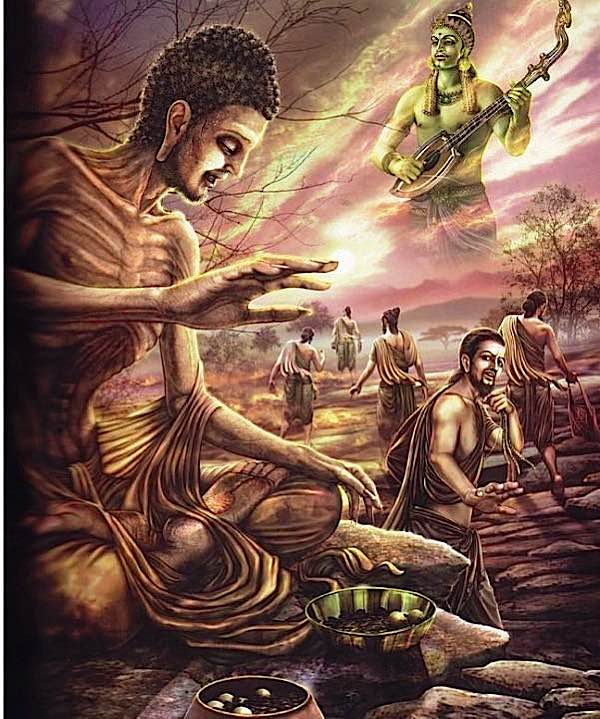 Buddha as the ascetic. Buddha starved himself eating only a grain of rice a day, seeking the answers through the ancient practices of asceticism.
Buddha as the ascetic. Buddha starved himself eating only a grain of rice a day, seeking the answers through the ancient practices of asceticism.
532-5238 B.C. Siddartha the Ascetic
Asceticism was an extreme form of practice that included living in the wild without protection, extreme fasting — basically, an attempt to “down the physical influence of one’s being and release the soul, an insubstantial essence in each individual.” [2]
He continued this until he was nothing but dry skin and bones, close to death.
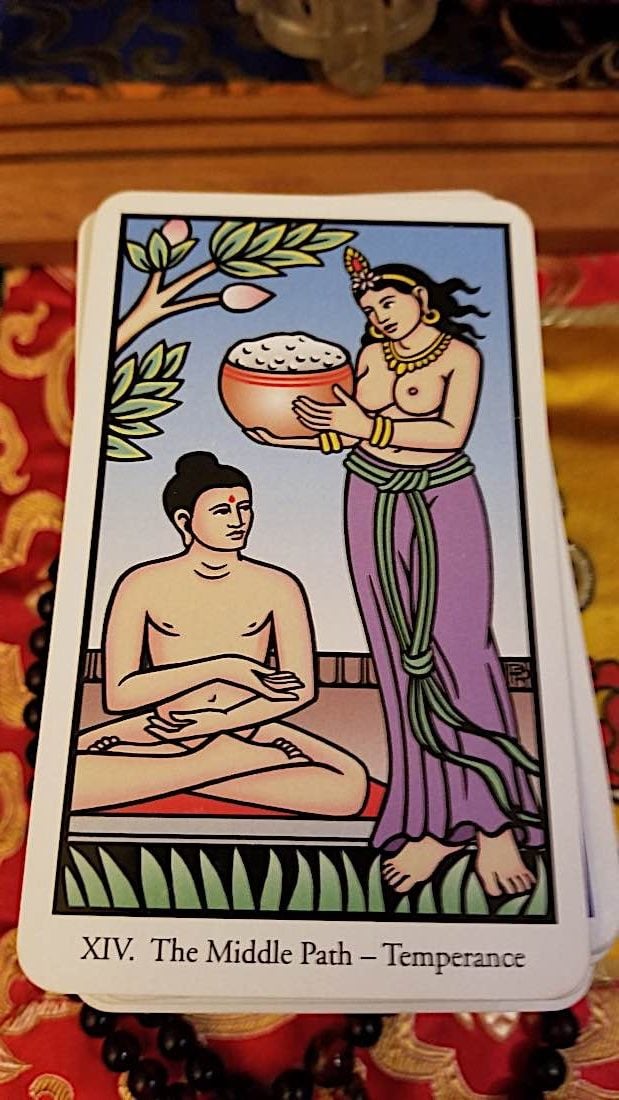 In Robert Place’s stunning Buddha Tarot, card XIV illustrates the moment of insight of the Buddha, after he had endured starvation and ascetic practices, that the “middle way” is the path to Enlightenment. Here, he is offered a bowl of rice at just that moment.
In Robert Place’s stunning Buddha Tarot, card XIV illustrates the moment of insight of the Buddha, after he had endured starvation and ascetic practices, that the “middle way” is the path to Enlightenment. Here, he is offered a bowl of rice at just that moment.
528 B.C. Siddartha risks death at Varanasi
Pushing his practice to the extreme, he tried every extreme meditation and practice — together with five other ascetics — only to nearly die of starvation. Finally, he realized the “middle way” was the correct path to Enlightenment — neither the extreme of deprivation nor its opposite of luxury. Barely able to move, he accepted a tiny bowl of mik, rice from a devotee named Sujata. From that moment, he pioneered the “Middle Path” now known as “Buddhism.”
 Mara’s army is swept away by a flood of merits. The Earth Mother rings out her hair releasing the torrent. In each of Buddha’s many lifetimes as a compassionate Bodhisattva, he accumulated drops of merit — released now as an epic flood on the day of his Enlightenment.
Mara’s army is swept away by a flood of merits. The Earth Mother rings out her hair releasing the torrent. In each of Buddha’s many lifetimes as a compassionate Bodhisattva, he accumulated drops of merit — released now as an epic flood on the day of his Enlightenment.
528 B.C. Awakening at Bodh Gaya
At Buddhism’s most “famous” site, Bodhgaya, Siddartha found the liberating path. Rejected by the five ascetics, he ate modest meals, recovering his strength, then moved to a new meditation site under the most famous tree in history — the Pipal Tree of Bodh Gaya. [A decedent of this tree is still honored today in Bodhgaya.]
He withdrew into his mind, pioneering a new “middle way” of meditating. He endured trials under the tree, tempted by the Mara and his legions and armies. [Mara and his legions, assailing the Buddha under the tree, can be thought of as the struggle Buddha faced internally with his own attachments and past karmic imprints.] Finally, he awakened, and Mara and his legions vanished. Famously, the symbol of this is Buddha touching the earth as his witness. He attained Bodhi — Awakening — and became the Buddha, the Awakened One.
 The Buddha teaching — his first teaching was on the Four Noble Truths.
The Buddha teaching — his first teaching was on the Four Noble Truths.
528 B.C. First Teaching at Sarnath
Buddha “turned the first wheel” of teaching, determined to help others with his perfect methods. His first pupils were the five ascetics who had earlier rebuked him. His first teachings were the Four Noble Truths, and the Eightfold Path:
Buddha first taught the Four Noble Truths, the Truth of Suffering, metaphorically, the “disease” we are treating.
“What, monks, is the truth of suffering? Birth is suffering, decay, sickness and death are suffering. To be separated from what you like is suffering. To want something and not get it is suffering. In short, the human personality, liable as it is to clinging and attachment brings suffering.” [3]
 Eightfold Path
Eightfold Path
Overcoming suffering relied on the Eightfold Path:
“This is the noble eightfold way, namely, right understanding, right intention, right speech, right action, right livelihood, right attention, right concentration, and right meditation.” — Shakyamuni Buddha at Deerpark
• For a feature on the Four Noble Truths and Eightfold Path, see>>
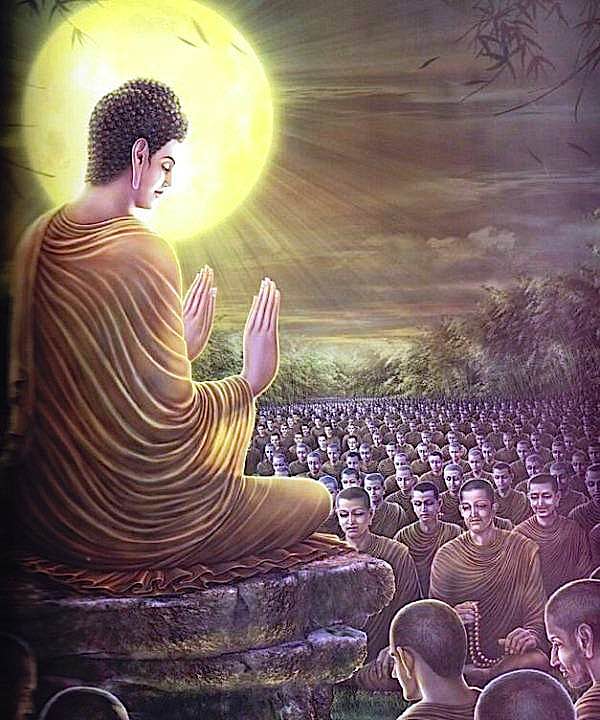 The Buddha continued to teach for 45 years to a growing group of committed monks and lay disciples.
The Buddha continued to teach for 45 years to a growing group of committed monks and lay disciples.
528-483 B.C. Countless teachings, Turning the Wheel
Buddha traveled with a growing entourage of disciples, teaching for the next 45 years. These precious teachings, recorded by his pupils, became a vast body of Pali Sutta, and later Mahayana Sutra — the largest collection of spiritual teachings in history. His teachings would spread throughout India, China, Japan, Korea, and all of Asia — and ultimately around the world.
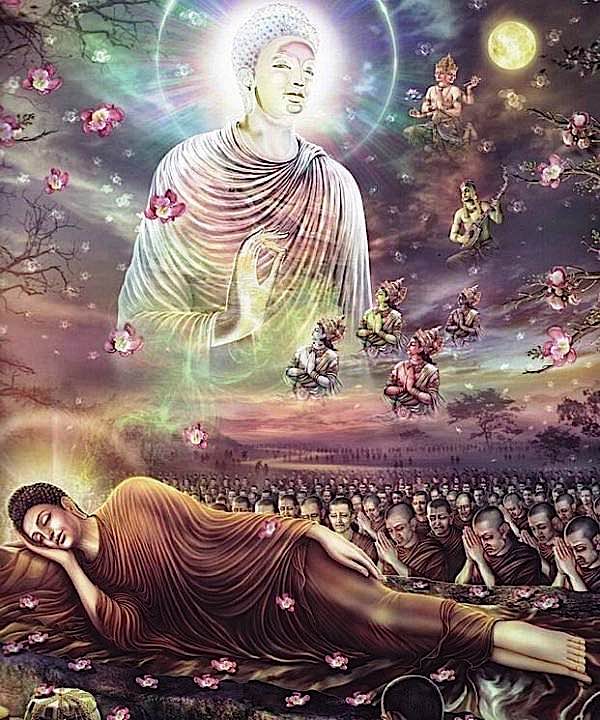 Shakyamuni Buddha practiced the eightfold path and taught it to his disciples. He attained Enlightenment.
Shakyamuni Buddha practiced the eightfold path and taught it to his disciples. He attained Enlightenment.
483 B.C. Paranirvana at Kusinagara, Malla
At the age of 80, he decided it was time for him to leave the teachings to his Sangha of disciples. He gave his last teaching. He asked his disciples if they had any last questions for him before he left.
Finally, he said, “Things that arise from causes will also decay. Press on with due care.”[3]
He lay down on his right side, with his hand under his face — in the pose made famous by the Sleeping Buddha statue — and passed into the peace of ultimate Paranirvana.

 ValVades
ValVades 







![Mondly Review: Excellent In Most Areas, But… [2021]](https://www.dumblittleman.com/wp-content/uploads/2021/08/hhhhh-1.png)
























